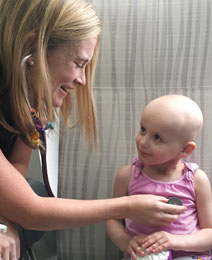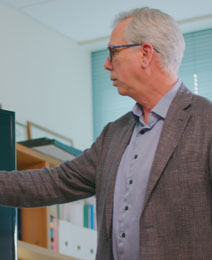Then and now: from a dismal past to a daring future for childhood cancer care
According to a medical textbook written in the 1930s, childhood leukemia was an untreatable condition that would inevitably lead to the child succumbing to the disease.
Dr. Rebecca Deyell, pediatric oncologist and investigator, Michael Cuccione Childhood Cancer Research Program (MCCCRP) at BC Children’s Hospital, was given that textbook by her grandfather, a family doctor. Flipping through the book was like looking back in time at the recent history of treatments for childhood cancers and seeing how dismal the health prospects used to be for children with cancer. “This was my grandfather’s textbook,” said Dr. Deyell. “It really wasn’t that long ago.”
Even up to the 1950s, surviving childhood cancers was a nearly hopeless prospect. With survival rates between 10 to 15 per cent, the vast majority of children diagnosed with cancer did not make it.
Gradually over the years, medical researchers developed treatments that steadily pushed those survival rates higher. With the creation of treatments like chemotherapy, radiation, and bone marrow and stem cell transplantation, more children were able to survive their cancer—but not without paying a price.
Many of the treatments for cancer were very harsh, hurting the patients even when cured. Some children suffered from devastating long-term side effects such as heart damage, hormone problems and permanent hearing loss. The very treatments meant to heal often harmed the kids, who grew into adults still dealing with the negative impacts of treatment.
We’ve come a long way, but is it enough?
With donations from generous British Columbians and organizations throughout the years, researchers at the MCCCRP at BC Children’s Hospital have made enormous advancements in therapies. Today the survival rate for children with cancer is approximately 80 per cent, a testament to medical experts at BC Children’s and around the world who have developed new and better ways to treat childhood cancers.
As far as we’ve come over the past century, there’s still a challenging road ahead. Currently, of the approximately 130 kids in BC diagnosed with cancer each year, one in five will not survive long-term—that’s a classroom full of kids.
For the hard-to-cure cancers kids need new treatments and new approaches so that the story of relapses and kids dying of cancer will hopefully one day be history.
– Dr. Rod Rassekh, pediatric oncologist and investigator, Michael Cuccione Childhood Cancer Research Program
Some young cancer patients suffer relapses, making it much less likely they will survive. Other kids have tough-to-cure cancers that require more specialized approaches—children like Ellie.
Ellie’s story

It was the last day of 2017 when Racyne found a lump on the neck of her two-year-old daughter Ellie. The family from Osoyoos learned, after they arrived at BC Children’s Hospital, that Ellie was suffering from a malignant rhabdoid tumour—which has only a 20 per cent chance of survival longer than five years after diagnosis.
Due to the rarity of this type of cancer, there was no standard treatment. Dr. Deyell checked the medical literature and the biggest case series she could find had only 26 kids, of which only one survived long-term. After extensively researching different treatment options, Dr. Deyell came up with a plan: six total rounds of chemotherapy, surgery to remove the tumour and 25 radiation treatments.
After seven and a half months in the hospital, Ellie and her family were finally able to go home. It’s been almost three years since then, and there’s no evidence of disease so far. Racyne and her family are deeply grateful Ellie is currently among the small percentage of kids who are surviving this rare condition, and they’re hopeful that some day every child with cancer will not only survive, but thrive.
The generosity of donors is what allows researchers to continue pursuing breakthroughs for future treatments, so we can help more kids like Ellie. We’re grateful for recent leadership donors—the Hudson family, Donald’s Fine Foods, and Donald and Julia Leung—for their passion and vision to build a better community and improve health care for children fighting cancers across British Columbia.
Hope on the horizon—with your help
Innovative areas of research are leading to promising new treatments.

“We’re going to a new level of personalization,” said Dr. Kirk Schultz, pediatric oncologist/hematologist and investigator with the MCCCRP at BC Children’s, “trying to identify the molecule changes, genetic changes within the cancer, and targeting it in more specific ways to increase cure rates and get safer cures with fewer complications.”
Right here in BC, we have world renowned pediatric oncology researchers who can tackle these challenges. BC Children’s is home to a unique collaboration of experts that is unlike anywhere else in the world.
We’ve made so much progress in treating childhood cancers since that 1930s textbook Dr. Deyell received from her grandfather. With your support researchers can get closer to developing safer treatments for childhood cancers, so new textbooks written in the years to come can describe effective ways to cure childhood cancers, save lives and give children their childhoods back.
“I want to see increased research,” said Dr. Deyell. “I want to see clinical trials that are designed for these rare kinds of tumors. I want to see results of targeted therapies. This work is critical. And none of it would be possible without donor support.”
“We can’t accept the status quo, we need to take it to the next level. What if we could do more for children with cancer?”
– Dr. Rebecca Deyell, pediatric oncologist and investigator, Michael Cuccione Childhood Cancer Research Program
CAR T-cell therapy: a promising path forward
One exciting area of research is focused on CAR T-cell therapy, a highly innovative approach to personalized medicine that can offer hope to kids whose hard-to-cure cancers haven’t responded to other available treatments. The Michael Cuccione Foundation, a BC-based global leader in raising support for childhood cancer research, has made a tremendous commitment to raise $10.5 million for this novel area of research.
This article was originally featured in the Fall 2021 issue of Shine magazine.
Shine Fall 2021 | Download the PDF

